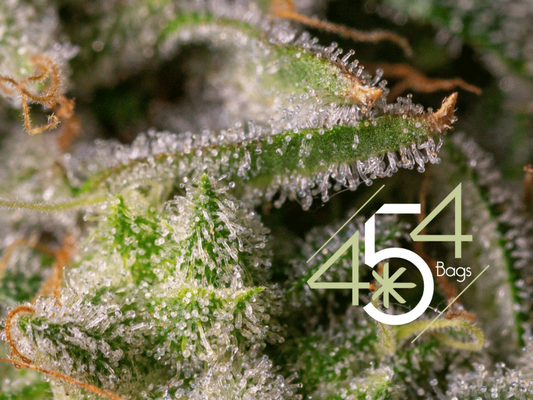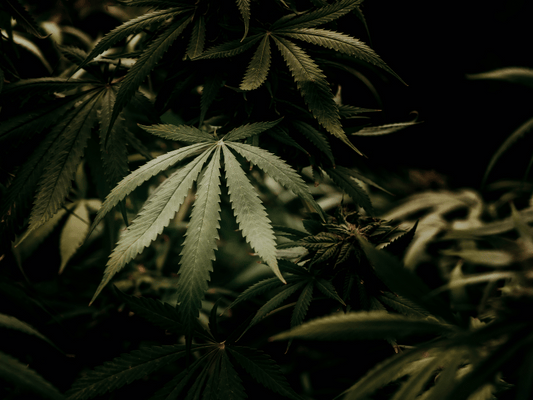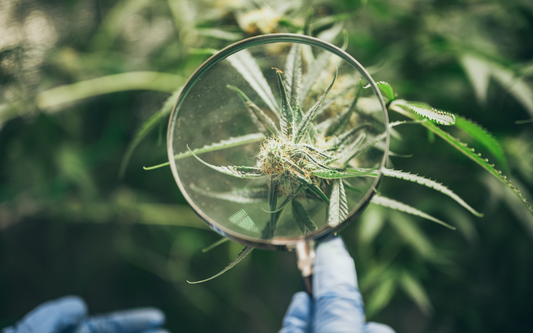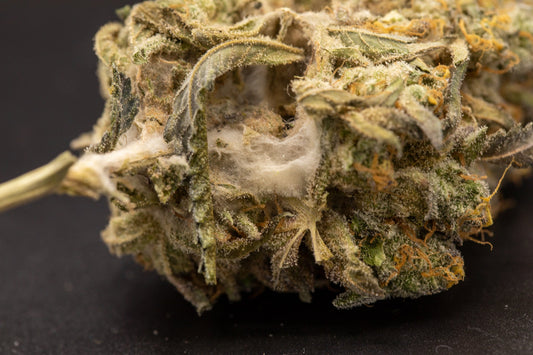Easy to order great service great product equals very happy customer
How to Identify Botrytis in Cannabis: Prevention During the Cure Stage

Identifying and Managing Botrytis in Cannabis: A Comprehensive Guide
Introduction and Importance of Identifying Botrytis
Identifying botrytis in cannabis, also known as bud rot or grey mold, is a crucial skill for any cannabis cultivator. This fungal pathogen can cause devastating losses to your harvest and significantly affect the quality of your buds. Spotting the early signs of botrytis in cannabis can help you mitigate its effects and even save your crop. This comprehensive guide will help you recognize and understand the symptoms of botrytis, what it looks like, how it affects your cannabis plants, and how to prevent it during the curing stage.
Understanding what Botrytis looks like is fundamental to early detection and the prevention of further spread. It's worth noting that although Botrytis primarily affects the buds, it can manifest on any part of the plant. Early detection and effective treatment can save your crops from significant damage.
Let's begin by delving into the early signs of Botrytis in cannabis.
Early Signs of Botrytis in Cannabis: Symptoms and Locations
-
Detecting the early signs of Botrytis in your cannabis crop is vital for preventing a devastating outbreak. The subtle shifts in your plants might indicate the inception of a Botrytis invasion. Here, we break down the early symptoms and frequent sites of Botrytis in your cannabis plants.
- Wilting and Discoloration: One of the initial signs of Botrytis is wilting, predominantly in buds. This wilting can be deceptive, appearing even when water supply is sufficient. Additionally, a grayish-brown hue in typically green buds and leaves signals infection, echoing the telltale discoloration of Botrytis blight or gray mold.
- Fuzzy, Powdery Appearance: The infamous Botrytis cinerea is a leading agent of bud rot. This fungus forms unique spore clusters on affected regions. Such spore groupings confer a fuzzy, powdery look upon the buds — a hallmark of a Botrytis infection. This texture might recall the symptoms of gray mold, where spore-producing structures make tissues look fuzzed to the naked eye.
- Brown or Gray Spots on Buds and Leaves: Early in its infection cycle, you could spot brown or gray patches on the buds and leaves of your cannabis plants. These spots usually mark the Botrytis fungus's first forays into colonizing the plant.
Common Locations for Botrytis
Botrytis typically targets the most vulnerable areas of the plant - buds, flowers, leaves, and stems. Damp, cool conditions, often found within dense cannabis canopies, create an ideal environment for Botrytis spores to germinate and spread.
The ability to identify the early signs of Botrytis infection is a crucial part of maintaining a healthy cannabis crop. By keeping a close eye on your plants and knowing what to look for, you can take swift action at the first sign of trouble, preventing a small problem from turning into a major outbreak.
Identifying Advanced Stages of Botrytis: Symptoms and Damage
As Botrytis progresses from the early to advanced stages, the symptoms become more pronounced, and the damage to your cannabis crop increases. Recognizing these advanced symptoms is essential for implementing immediate control measures to salvage as much of your crop as possible. Here, we delve into the indicators of advanced Botrytis infection and the potential damage it can cause.
- Advanced Symptoms of Botrytis: When Botrytis infection advances, the grayish-brown discoloration of buds and leaves becomes more widespread, often accompanied by a damp, musty smell. The buds may start to rot from the inside, with the outer leaves appearing healthy while the inside is infected. Eventually, these infected buds can become mummified, turning into a hard, dry mass.
- Fungal Growth and Spore Production: In the advanced stages, Botrytis starts producing a mass of spores on the surface of the buds and leaves. This spore production often manifests as a powdery, gray mold that gives Botrytis its common name - gray mold.
- Damage to Cannabis Crop: Advanced Botrytis infection can cause severe damage to your cannabis crop, reducing both yield and quality. In addition to causing rot in buds and leaves, Botrytis can spread throughout the plant, causing widespread damage. If left unchecked, a Botrytis outbreak can result in the loss of large sections, if not all, of your cannabis crop.
Recognizing the symptoms of advanced Botrytis is key to taking swift action and implementing control measures to salvage your cannabis crop. However, prevention is always better than cure, and knowing how to prevent Botrytis from reaching the advanced stages is critical. In the next section, we'll delve into preventive measures you can implement to protect your cannabis plants from Botrytis.
Is Botrytis Harmful to Humans?
A common question asked by many cannabis cultivators and users is, "Is Botrytis harmful to humans?" This is an important concern, particularly for those growing cannabis for medicinal or personal use.
While Botrytis cinerea is not generally considered harmful to humans, it can produce mycotoxins that might have negative health effects, especially in people with weakened immune systems or allergies to mold. These mycotoxins can cause a range of symptoms, including allergic reactions, respiratory problems, and in severe cases, even systemic infections.
In addition to the potential health risks, consuming cannabis buds infected with Botrytis is highly unadvisable. The presence of the fungus significantly affects the taste, smell, and overall quality of the buds.
Most importantly, smoking or vaporizing moldy cannabis can lead to serious health issues, including lung infections. The high temperatures involved in smoking can potentially release harmful compounds that can be inhaled directly into the lungs. Therefore, it's crucial to ensure that the cannabis you consume is free from Botrytis or any other type of mold.
The Complex Nature of Botrytis and Its Systemic Behavior
A critical aspect of understanding the control of Botrytis is deciphering its potentially systemic nature. The question, "Is Botrytis systemic?" arises frequently among growers, and for good reason. This attribute refers to the pathogen's ability to infiltrate the plant's internal systems and spread within it, much like certain diseases can spread internally within the human body.
Botrytis cinerea primarily functions as a necrotrophic fungus. In simpler terms, this means it mainly feeds and thrives on dead or dying plant tissue. Botrytis usually makes its way into a plant through wounds or openings, often those created by processes such as pruning or damage from pests. Once the fungus gains entry, it employs a strategic and destructive method to continue its lifecycle.
The mold releases specific enzymes and toxins that actively kill the cells and tissues of the host plant, creating more dead matter to feed upon. This process not only accelerates the spread of the fungus in the affected area but also paves the way for a potential deeper invasion into the plant's system.
While Botrytis isn't typically classified as a systemic pathogen, it can exhibit traits that resemble systemic behavior under specific conditions. Certain strains of Botrytis might even demonstrate more systemic tendencies than others. A key factor that plays into this systemic-like behavior is the health status of the host plant. Cannabis plants that are under stress, whether due to environmental factors or other diseases, are more susceptible to an aggressive, widespread Botrytis infection.
Thus, when it comes to managing Botrytis, it's vital to keep in mind that the visible symptoms are just the tip of the iceberg. The actual extent of the infection could be much more widespread than what is visible on the plant's exterior. A thorough examination and swift action are necessary to prevent further progression of the disease.
Preventing and Treating Botrytis in Cannabis: Strategic Measures
The old adage "prevention is better than cure" holds true when dealing with Botrytis in cannabis. Implementing preventive measures can help keep this pervasive fungus at bay, while timely treatment can stop an outbreak in its tracks. In this section, we outline the strategies that you can employ to prevent and treat Botrytis in your cannabis crop.
- Preventive Measures: Preventing Botrytis begins with cultivating a healthy growing environment. This includes managing humidity levels, ensuring proper ventilation, and maintaining appropriate plant spacing to prevent overcrowding. Regular inspection of your plants for early signs of Botrytis and immediate removal of infected plant parts can also prevent the spread of the fungus.
- Cultivating Resilience: Fostering plant health and resilience can be an effective strategy for preventing Botrytis. Healthy, strong plants are more capable of resisting infection. This can be achieved through proper nutrition, careful watering practices, and the use of disease-resistant strains.
- Treatment Options: If Botrytis infection occurs, it's crucial to act promptly. Treatments include removing and destroying infected plant parts to prevent the spread of the fungus. Fungicides can also be used, though it's essential to use these products responsibly to avoid resistance development in the fungus and potential harm to beneficial organisms.
- Post-Infection Care: After treating Botrytis infection, it's essential to monitor the plants closely for signs of re-infection. Additional preventive measures may be necessary to protect your crop, particularly if conditions conducive to Botrytis development persist.
Understanding the strategies for preventing and treating Botrytis in cannabis can help you safeguard your valuable crop from this devastating fungus. The next section will explore measures to prevent Botrytis during the cure stage, focusing on the importance of 'burping' when storing cannabis in turkey bags.
The Essential Role of Trimming Gloves in Cannabis Cultivation
Trimming is a critical process in cannabis cultivation, often raising the question: "What kind of gloves do you use to trim cannabis?" This question carries significant weight as the choice of gloves directly impacts the overall quality and safety of the cannabis product, especially in terms of preventing diseases like Botrytis.
The importance of suitable trimming gloves cannot be overstated. Trimming cannabis buds involves direct contact with the plant material, and using the wrong type of gloves, or not using gloves at all, could potentially introduce contaminants, such as Botrytis spores, onto the buds. The result could be a deterioration of product quality, or in the worst-case scenario, a widespread infection.
Among the many types of gloves available, nitrile gloves stand out as the preferred choice for many cannabis growers. They offer an excellent balance of durability, puncture-resistance, and sensitivity, which are crucial for the delicate task of trimming cannabis buds. They also protect growers from a variety of chemicals, a critical factor considering that many treatments for Botrytis and other pathogens involve chemical fungicides.
For individuals with a latex allergy, a question that often comes up is, "What gloves do not contain latex?" Here, nitrile gloves again come to the fore, being latex-free and thus safe for individuals with a latex allergy. This attribute makes them a versatile and safe choice for cannabis growers.
Selecting the right gloves is an integral part of a comprehensive Botrytis management strategy. By ensuring that your trimming process is carried out with high-quality, latex-free nitrile gloves, you take a significant step in preventing Botrytis and ensuring the safety and quality of your cannabis product.
The Comprehensive Approach to Managing Botrytis
In conclusion, effectively managing Botrytis in cannabis requires an integrated approach that combines knowledge, vigilant prevention strategies, and the use of appropriate tools. Botrytis cinerea, a ubiquitous fungus, poses a significant threat to cannabis cultivators. However, with the right strategies in place, it's possible to mitigate the risks it presents.
The comprehensive knowledge we've discussed in this blog post, from early detection to understanding the systemic nature of the pathogen, forms the foundation of effective Botrytis management. These insights provide the necessary tools to diagnose, prevent, and react swiftly should an outbreak occur.
Equally critical is the role of personal protective equipment in maintaining the health of your cannabis plants, especially during the handling and trimming process. Using appropriate trimming gloves, such as durable, puncture-resistant, and latex-free nitrile gloves, can significantly minimize the risk of cross-contamination.
Furthermore, utilizing a holistic Integrated Pest Management (IPM) approach that employs multiple control methods can be instrumental in keeping your cannabis plants healthy and Botrytis-free.
In the end, while Botrytis presents a considerable challenge to cannabis cultivation, with diligent management, a keen eye for early symptoms, and good cultivation practices, its impact can be effectively controlled. As we continue to learn more about this pathogen, we enhance our ability to protect cannabis crops and ensure a successful harvest. Let's carry on this journey of knowledge and growth towards a healthier, more sustainable future in cannabis cultivation.
No comments









0 comments